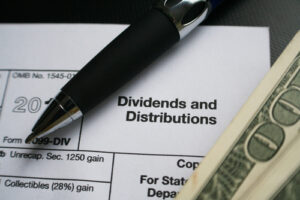Tax implications of a dividend
What is a dividend?
Do you wonder, “What is a dividend?” Here’s the answer: Dividends are distributions of money, stock, or other property. A corporation pays you in these if you own stock in that corporation. You also might receive dividends through:

- Mutual funds
- Partnerships
- Estates
- Trusts
- S corporations
- Associations taxed as a corporation
Ordinary dividends are the most common type of dividends. They’re taxable as ordinary income unless they’re qualified dividends. Qualified dividends are dividends taxed at the lower rates that apply to net long-term capital gains. Qualified dividends must meet be:
- Distributed by a U.S. company or a qualifying foreign company, and
- Given for a stock you owned for 60 days out of a 121-day period. The holding period starts 60 days before the ex-dividend date related to the dividend.
There are a few types of stock that are not eligible for qualified dividend treatment even if the dividends satisfy the two rules above.
Qualified dividends are taxed at capital gain rates of 0%, 15%, or 20%, depending on your tax bracket. If you are:
- In the 10% or 12% tax bracket, your qualified dividends are taxed at 0%,
- In the 22%, 24%, 32%, or 35% tax bracket, your qualified dividends are taxed at 15%, and
- In the 37% tax bracket, your qualified dividends are taxed at 20%.
Taxation of dividends
Wondering about the taxation of dividends? You should receive a Form 1099-DIV from each payor for distributions of $10 or more.
And, here’s another tax on dividends tip: if you receive dividends through a non-corporate entity, you should receive a Schedule K-1. It’ll show the dividends taxable to your:
- Partnership
- Estate
- Trust
- S corporation
Do you need to report dividends on your return?
If you didn’t receive a Form 1099-DIV or Schedule K-1, you’ll still need to report all taxable dividends on your return.
Are there other rules for dividends?
Yes, there are a few other types of dividend transactions. Let’s talk about them one at a time.
What are nondividend distributions?
While most dividend distributions are taxable, some are not. These are called nondividend distributions. Unlike ordinary and qualified dividends, these do not come out of a corporation’s earnings and profits. Nondividend distributions are a non-taxable return of capital.
A return of capital is a return of some of your investment in the stock of the company. A return of capital distribution:
- Reduces the basis of your stock
- Isn’t taxed until your basis in the stock is fully recovered
After the basis of your stock is reduced to zero, any further return of capital is taxed as a capital gain.
What is a liquidating distribution?
A corporation you own stock in might partially or completely liquidate. In that case, the corporation pays you a liquidating distribution. Liquidating distributions are a return of capital that reduces your basis in the stock. Any liquidating distribution that is more than your basis is treated as a capital gain.
What are capital gain distributions?
Capital gain distributions might be paid by one of these:
- Regulated investment companies (mutual funds)
- Real estate investment trusts (REITs)
Capital gain distributions are always reported as long-term capital gains. You must also report any undistributed capital gain that mutual funds or REITs have designated to you in a written notice. Those undistributed capital gains are reported to you on Form 2439.
Form 1099-DIV should list the distribution in the various categories. If it doesn’t, contact the payor.
More help with taxes on dividends
Investment income poses special considerations come tax time, including special filing requirements. Whether you make an appointment with one of our knowledgeable tax pros or choose one of our online tax filing products, you can count on H&R Block to help you get back the most money possible.
Was this topic helpful?
